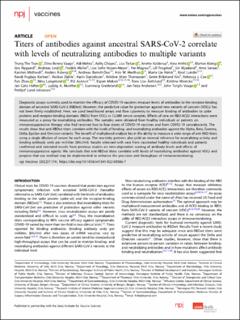Titers of antibodies against ancestral SARS-CoV-2 correlate with levels of neutralizing antibodies to multiple variants
Tran, Trung The; Vaage, Eline Benno; Mehta, Adi; Chopra, Adity; Tietze, Lisa; Kolderup, Anette; Anthi, Aina Karen; König, Marton; Nygaard, Gro Owren; Lind, Andreas; Müller, Fredrik; Nissen-Meyer, Lise Sofie Haug; Magnus, Per Minor; Trogstad, Lill; Mjaaland, Siri; Søraas, Arne Vasli; Midtvedt, Karsten; Åsberg, Anders; Barratt-Due, Andreas; Medhus, Asle Wilhelm; Høivik, Marte Lie; Lundin, Knut; Karlsen, Randi Fuglaas; Dahle, Reidun; Danielsson, Karin; Thomassen, Kristine Stien; Kro, Grete Anette Birkeland; Cox, Rebecca Jane; Zhou, Fan; Langeland, Nina; Aukrust, Pål; Melum, Espen; Åvitsland, Tone Lise; Wiencke, Kristine; Holter, Jan Cato; Munthe, Ludvig Andre; Grødeland, Gunnveig; Andersen, Jan Terje; Vaage, John T.; Lund-Johansen, Fridtjof
Journal article, Peer reviewed
Published version

Åpne
Permanent lenke
https://hdl.handle.net/11250/3043266Utgivelsesdato
2022Metadata
Vis full innførselSamlinger
- Department of Clinical Science [2318]
- Registrations from Cristin [9791]
Sammendrag
Diagnostic assays currently used to monitor the efficacy of COVID-19 vaccines measure levels of antibodies to the receptor-binding domain of ancestral SARS-CoV-2 (RBDwt). However, the predictive value for protection against new variants of concern (VOCs) has not been firmly established. Here, we used bead-based arrays and flow cytometry to measure binding of antibodies to spike proteins and receptor-binding domains (RBDs) from VOCs in 12,000 serum samples. Effects of sera on RBD-ACE2 interactions were measured as a proxy for neutralizing antibodies. The samples were obtained from healthy individuals or patients on immunosuppressive therapy who had received two to four doses of COVID-19 vaccines and from COVID-19 convalescents. The results show that anti-RBDwt titers correlate with the levels of binding- and neutralizing antibodies against the Alpha, Beta, Gamma, Delta, Epsilon and Omicron variants. The benefit of multiplexed analysis lies in the ability to measure a wide range of anti-RBD titers using a single dilution of serum for each assay. The reactivity patterns also yield an internal reference for neutralizing activity and binding antibody units per milliliter (BAU/ml). Results obtained with sera from vaccinated healthy individuals and patients confirmed and extended results from previous studies on time-dependent waning of antibody levels and effects of immunosuppressive agents. We conclude that anti-RBDwt titers correlate with levels of neutralizing antibodies against VOCs and propose that our method may be implemented to enhance the precision and throughput of immunomonitoring.
